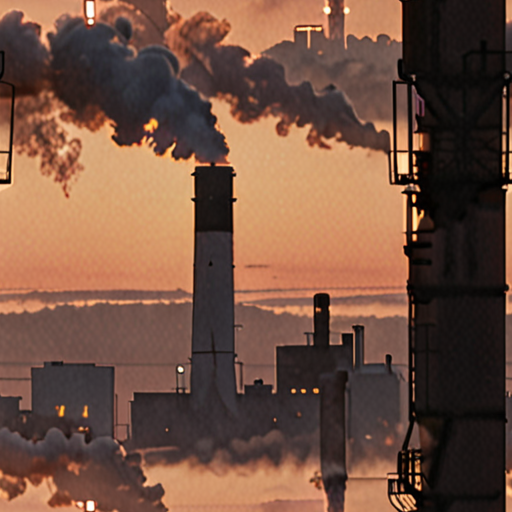The debate surrounding pyrolysis and its impact on environmental health has been ongoing for years, with proponents arguing that it offers a sustainable solution for waste management and critics claiming that it poses significant risks to the ecosystem. As the world grapples with the challenges of climate change, renewable energy sources, and waste disposal, understanding the intricacies of pyrolysis has become increasingly crucial. This complex process involves the thermal decomposition of organic materials, resulting in the production of bio-oil, syngas, and char. While pyrolysis has shown promise as a means of reducing greenhouse gas emissions and generating clean energy, its environmental implications remain shrouded in controversy.

Is Pyrolysis Harmful to the Environment?
No, it is not harmful when done properly.
- The key to minimizing environmental harm lies in implementing pyrolysis processes that adhere to strict safety standards and regulations.
- Pyrolysis facilities must be designed and operated with careful consideration for air and water pollution control measures.
- Regular monitoring and maintenance of equipment are crucial to prevent emissions and spills.
Benefits of Properly Implemented Pyrolysis
- Production of clean energy through the conversion of organic waste into biofuels and electricity.
- Creation of valuable products such as biochar, which can be used as a soil amendment to enhance fertility and carbon sequestration.
- Reduction of greenhouse gas emissions by replacing fossil fuels with renewable energy sources.
Risks Associated with Improper Implementation
- Pollution of air and water due to inadequate emissions controls and spillage.
- Release of toxic chemicals into the environment, posing risks to human health and ecosystems.
- Unintended consequences of altering local ecosystems through the introduction of invasive species or altered nutrient cycles.
Best Practices for Sustainable Pyrolysis
- Invest in state-of-the-art technology and equipment designed for efficient and safe operation.
- Implement robust training programs for personnel to ensure they understand the importance of safety protocols.
- Maintain open communication channels with regulatory bodies and neighboring communities to address concerns and share knowledge.
Hazards of Pyrolysis
Pyrolysis, a process that converts organic materials into valuable resources, poses several inherent hazards.
- Fire and Explosion Risk
- Accidental Release of Toxic Gases
- Environmental Concerns
- Equipment Damage
- Operator Safety
The high temperatures involved in pyrolysis can lead to fires and explosions, posing significant risks to personnel and equipment.
During the pyrolysis process, toxic gases such as carbon monoxide may be released accidentally, posing health risks to nearby individuals.
Pyrolysis can result in the release of pollutants and greenhouse gases, contributing to environmental degradation and climate change.
The high heat and pressure involved in pyrolysis can cause damage to equipment, leading to costly repairs and downtime.
Operators working with pyrolysis equipment must take necessary precautions to prevent exposure to hazardous conditions, including heat stress and chemical burns.
Understanding these hazards is crucial for implementing effective safety measures and minimizing risks associated with pyrolysis.
Precautions and Best Practices
To mitigate the hazards of pyrolysis, it is essential to implement robust safety protocols, including regular maintenance, proper training, and adherence to established guidelines.
- Regular Equipment Maintenance
- Proper Training and Education
- Adherence to Guidelines and Regulations
Maintaining equipment in good condition helps prevent accidents and ensures smooth operation.
Operators must receive thorough training on pyrolysis processes, safety procedures, and emergency protocols.
Familiarity with local regulations and industry standards is vital for ensuring compliance and minimizing risks.
By prioritizing safety and adopting best practices, operators can minimize the hazards associated with pyrolysis and promote a safer working environment.

Environmental Benefits of Pyrolysis
As a pioneer in sustainable living and eco-friendly technologies, I’m excited to share the numerous environmental benefits of pyrolysis.
- Reducing Harmful Emissions
- Preventing Marine Pollution
- Supporting a Net-Zero Economy
- Conserving Natural Resources
- Improving Soil Health
Pyrolysis helps minimize greenhouse gas emissions by converting organic waste into valuable resources like biochar, which can store carbon for centuries.
By transforming plastic waste into bio-oil, syngas, and biochar, pyrolysis reduces the risk of plastic waste entering our oceans and harming marine life.
Pyrolysis plays a crucial role in transitioning to a net-zero economy by producing renewable energy and enabling carbon sequestration through biochar production.
Pyrolysis helps conserve natural resources by recycling waste materials, reducing the need for virgin raw materials, and minimizing landfill waste.
Biochar produced through pyrolysis can enhance soil fertility, structure, and water-holding capacity, promoting healthy plant growth and reducing the need for synthetic fertilizers.
At Pyrolysium , we’re committed to spreading awareness about the importance of pyrolysis in achieving a more sustainable future.
We believe that by working together, we can create a world where waste is valued, and the environment is protected for generations to come.
Join us in our mission to promote sustainable living and eco-friendly technologies, and let’s work towards a brighter, more environmentally conscious tomorrow.

Is Pyrolysis Oil Environmentally Friendly?
The production of pyrolysis oil has been a topic of debate regarding its environmental impact.
- Pyrolysis oil, also known as bio-oil, is a renewable energy source derived from the thermal decomposition of organic materials such as biomass, tires, and plastics.
- While pyrolysis oil offers several benefits, including reduced greenhouse gas emissions and increased energy independence, its environmental friendliness is still a subject of discussion.
Concerns Surrounding Pyrolysis Oil Production
One major concern surrounding pyrolysis oil production is the potential release of pollutants during the process.
- Nitrogen, sulfur compounds, and polycyclic aromatic hydrocarbons (PAHs) have been identified as pollutants present in pyrolysis oil.
- Higher temperatures used in the pyrolysis process can lead to the formation of more PAHs, which are known to be carcinogenic and mutagenic.
- Burning pyrolysis oil can result in the emission of gaseous pollutants, posing environmental concerns.
Evaluating the Environmental Impact of Pyrolysis Oil
To determine whether pyrolysis oil is environmentally friendly, we need to consider various factors, including:
- Energy efficiency and greenhouse gas emissions reduction
- Pollutant release and air quality impacts
- Waste management and resource utilization
Conclusion is Not Required
By examining these factors, we can gain a better understanding of the environmental implications of pyrolysis oil production and consumption.
Why We Don’t Use Pyrolysis
One major reason why pyrolysis isn’t widely adopted is due to its high energy requirements. Producing synthetic fuel through pyrolysis demands extremely high operating temperatures, which translates to significant amounts of energy consumption. In fact, studies have shown that the amount of energy needed to produce synthetic fuel via pyrolysis is approximately 87 times higher than the actual energy obtained from the synthetic fuel itself. This makes pyrolysis an inefficient method for generating energy, particularly when compared to other alternatives.
Energy Intensity of Pyrolysis
To put this into perspective, consider the following breakdown of energy inputs and outputs associated with pyrolysis:
- High operating temperatures: Pyrolysis requires extremely high temperatures, often exceeding 500°C, to initiate the decomposition of organic materials.
- Significant energy consumption: The energy required to heat these materials to such high temperatures is substantial, resulting in a considerable increase in overall energy expenditure.
- Inefficient energy conversion: Despite the high energy input, the efficiency of energy conversion during pyrolysis is relatively low, leading to a net loss of energy.
Alternative Energy Solutions
Given the energy-intensive nature of pyrolysis, it’s essential to explore alternative methods for generating energy. Some viable options include:
- Solar power: Harnessing solar energy through photovoltaic panels or concentrated solar power systems offers a cleaner and more efficient means of producing electricity.
- Wind power: Wind turbines can capture kinetic energy from wind currents, converting it into electrical energy with minimal environmental impact.
- Biomass energy: Burning biomass fuels, such as wood or agricultural waste, can provide a renewable source of energy while reducing greenhouse gas emissions.
Conclusion
While pyrolysis has potential applications in certain contexts, its high energy requirements and inefficiencies make it less desirable as a primary means of energy production. By exploring alternative energy solutions, we can move towards a more sustainable future with reduced reliance on fossil fuels and lower carbon emissions.
The Problem with Pyrolysis Oil
Incompatibility with different plastic types, low yield, and contamination of pyrolysis oil mean it must be diluted by a petroleumbased mixture, in some cases by a ratio of over 40:1.
- Limitations of Pyrolysis Recycling
- Pyrolysis recycling has several limitations, including:
- Incompatibility with different plastic types
- Low yield of usable oil
- Contamination of pyrolysis oil
- Necessity for dilution with petroleumbased mixtures
This makes pyrolysis oil less desirable compared to traditional fossil fuels, which have a higher energy density and are easier to transport and store.
Comparison to Traditional Fossil Fuels
Traditional fossil fuels have several advantages over pyrolysis oil, including:
- Higher energy density
- Easier transportation and storage
- Wider availability and lower cost
Conclusion
While pyrolysis oil shows promise as a renewable energy source, its limitations and drawbacks make it less desirable compared to traditional fossil fuels. Further research and development are needed to overcome these challenges and make pyrolysis oil a viable alternative to traditional energy sources.

0 Comments